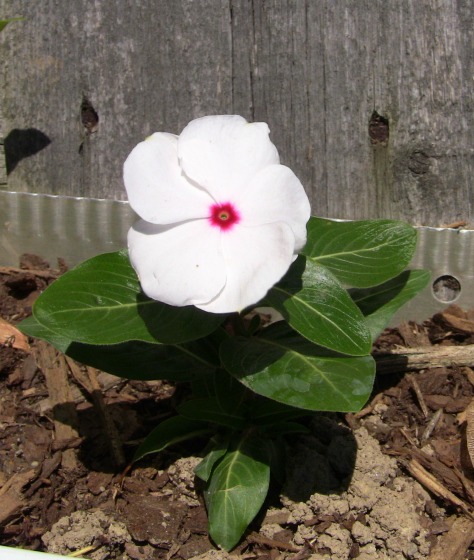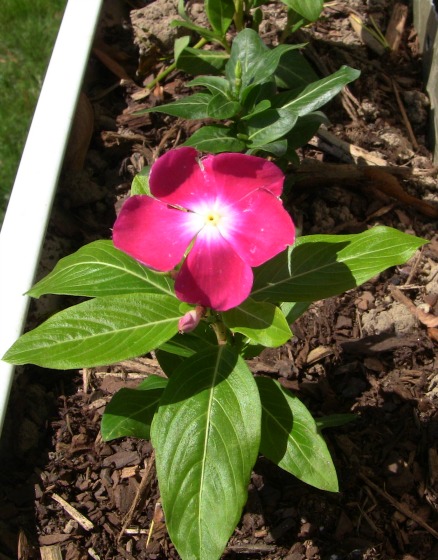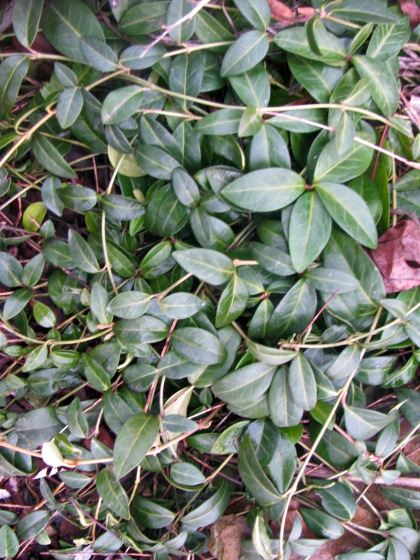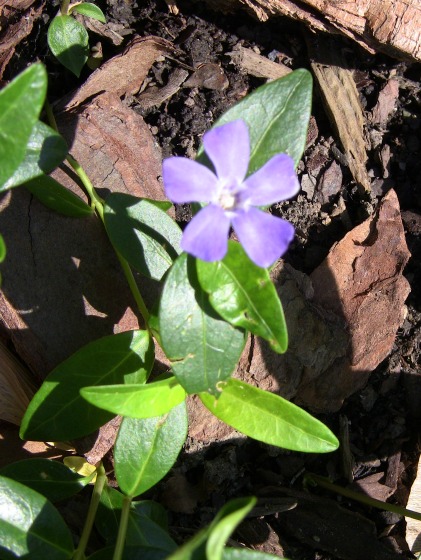What is commonly referred to as vinca, can be found as both an annual and perennial…but they are not the same plant. Let me explain:
Perennial vinca (sometimes called periwinkle or creeping myrtle) can be found in two basic forms: Vinca minor and Vinca major. Vinca major is slightly bigger, slightly less cold hardy and slightly less shade tolerant than vinca minor. There is also a herbaceous vinca, but we won’t get into that.
Annual vinca isn’t even vinca …and its not always an annual. When botanists first discovered it, they thought it looked similar to vinca and named it Vinca rosea. They later discovered that it behaves quite differently than vinca and changed its name to Catharanthus roseus. By that time it was too late and the name had already stuck.
♪♪ You say vinca, I say Catharanthus roseus ♪♪
For practical purposes I’ll call these plants Annual Vinca and Perennial Vinca. This is all you’ll need to know when buying them at the store. Only overly educated plant geeks (like myself) will want to explain the name difference to you.
Lets talk about the Annuals.
In India annual vinca are called Sadaphuli. The name means always flowering. These beauties will flower from early spring until late fall if the weather stays reasonably warm. Vinca flowers can range from white to shades of purple, pink and red. They are tidy little plants. No need to deadhead the spent blooms. This plant is self cleaning.
Its foliage is dark green and leathery, with a shiny appearance. They look so good, you’d swear they are fake! Because each plant it compact and low growing (under 2 ft) they make great border plants. Annual vinca do really well in heat and drought. Although they don’t particularly like cool temperatures or moisture, they will grow nicely in most climates in the summertime. They prefer full sun, but they’ll do just fine in partial sun.
Annual vinca is a tropical/subtropical plant. In hot areas, they grow as a perennial. In warm areas they grow as a self seeding annual. In cooler areas, like here in NE Ohio, they will usually need to be planted each year.
Annual vinca is not terribly hard to grow from seed as long as you are careful with your moisture levels. Too much moisture in the soil can cause the seeds to rot or the seedlings to have fungal issues. (Something else helpful to know: They germinate in the dark.) Its pretty inexpensive to just buy the plant at a garden center. Around here, Walmart sells them in packs of 6 for under $2.00. Water them right after planting, then not again unless you see the leaves start to curl.
Now lets talk about Perennials.
Perennial vinca (called vinca major and minor) are trailing evergreen vines. They don’t climb like ivy, but spread low across the ground. Perennial vinca grows best in shady areas and prefers cool, moist soil. Once they become established they will begin to spread. In some states they are on the invasive plant list. Vinca major is more aggressively invasive than vinca minor.
Although invasive, vinca minor is still sold as a common ornamental ground cover and is great for covering up unsightly objects- like tree stumps. Vinca minor, in most cases, will not choke out other plants growing in the area. They just fill in around them. Vinca major, being more aggressive, can take over other plants in your flower bed. There are variegated leaf varieties of vinca minor that are said to be easier to control.
I have vinca minor growing in a landscape bed between my driveway and front lawn. I planted a little and it spread quickly in areas where I wanted it to. I have not found it hard to contain. My normal lawn mowing routine has been enough to keep stray vines from trying to root into my grass. It added color to a shady area of my landscape and since it has filled in, I no longer need to mulch that bed.
Vinca major has larger leaves and larger flowers than vinca minor. Both bloom early spring into late fall. Purplish-blue flowers are most common, although there are some cultivators that produce white and red flowers. The blooms on vinca minor are relatively small- they measure about an inch across. Vinca major boasts blooms that are double that size.
Perennial vinca can be grown from seed and is easily grown from cuttings. Perennial vinca have 2 types of stems: flowering and rooting. Simply select a vine that does not have a flower and root it as a softwood cutting.
Major vs Minor (Is it little league season yet?)
Vinca Minor:
- smaller leaves and flowers
- thrives in shade
- perennial evergreen
- less invasive
- grow to about 1 ft and are more compact than vinca major
Vinca Major:
- larger leaves and flowers
- slightly less shade tolerant
- slightly less cold tolerant
- more invasive
- grow to about 2 ft high
Vinca flowers are a low maintenance way to add color to your garden and landscapes, but there are big differences between the annual vinca and perennial vinca. Let’s recap.
Annual Vinca:
- Thrives in hot, dry temperatures
- Full sun
- Self seeding annual in warm climates
- Neat, compact border plant
Perennial Vinca:
- Cool, moist soil
- Great for shady areas
- Evergreen vine
- Used as spreading ground cover
- Can be invasive





Hello to the extend group,
I live in So Cal in the Ventura area, the climate overall is mild to warm. I have a section of land facing due north on a slope that I planted Vinca Minor, it has grown in nicely. I truly like the low lush leafing and purple hew flowers (periwinkle)..
I have another section I’d like to extend using Vinca Minor, but I would like to know is, if “Vinca minor Multi-Colour” is a truly a plant that can purchased in our area.. I have been calling the local nurseries but no one has heard of this varietal
Does “Vinca minor” come is other colors besides the periwinkle pale purple?
I located this site, but it is in the UK. and I tend to wonder if these are really plants that can be purchased in USA. Possibly a Hybrid of sorts??
I tried to contact these folks but using a simple phone doesn’t work and the Chatbot is just that… I want a to talk to a person 😉 not a machine.
Anyway if folks reading this thread have seen Vinca-Minor in multi colours that would be great to get information on.
Thank you
Steve
They have a lot of different colored Vincas at Farwest Nursery, Eagle Idaho Hope that helps!
Oops, it’s Boise Idaho!
My pink and purple peri winkle flowers turned into white. Whats the cause of it? Any suggestions to get the original color back?
Hmmmm? I honestly don’t know.
I have an ocean of vinca minor. I want to harvest it for wholesale sale. How would you suggest to harvest it?
Thanks
Jeff
Jeffrey,
Before you can wholesale those plants you need to be licensed and the plants inspected. All growers are inspected at least once a year. Then you can harvest them as bare root clumps.
I have wha I think is Vinca, but it is definitely climbing both my Kolkwitzia bush, my fence, and my cedar tree. It is evergreen. What could it be if not a Vinca?
Carole,
I’m not sure.
My 143 Annual Vinca started with normal flowers – full overlapping petals… now some are flowering narrow petals… why?
Nick,
I honestly don’t know.
Hi Mike. I’m wondering if annual Vinca leaves are safe to compost or should I get rid of them? I’ve always thought “vinca” was poisonous, but just recently came across a brief remark that either vinca major or minor (can’t remember which) had 2 chemicals used in chemo, but we’re not considered poisonous (although chemo is somewhat) and the other was poisonous. There was no mention of annual/Cantharanthus Vinca.
I planted some pink annual vincas next to some daylilies. The pink flowers turned pure white in less than 10 days. The soil isn’t that great, but I wasn’t expecting that! Not complaining, but caused the change?
Di,
I really can’t say, could have something to do with the variety of Vinca you bought, or could be soil. Not sure.
Hi Mike,
Can vinca minor cross pollinate with vinca major? I swear we planted vinca minor last year, but this year some are growing as the “minor” in used to, and other parts of the cover seem slightly taller, wider leaves, and a yellower hue. It looks more like vinca major!
Do you what might be happening? Will the vinca major continue to take over?
Thank you!!
Elana,
I don’t honestly know, I’m sure it can, but that would be seedlings that would be different, not shoots from the parent plants.
My vinca’s are beautiful this summer, I would really like for them to self seed. When they die, should I leave them like they are until next spring or should I cut them and shake them over the ground?
Kim,
I’d either shake them over the area or collect the seeds and germinate them in more controlled environment. I’ve got a post on this site about growing perennials from seed.
Sorry for the typos in my previous jobs message. When I was speaking of the bulbs my cousin has I also mentioned she had some “Lucille” this should have read liriope. Don’t you just love the auto correction feature. LOL. Also the correct email address is the one for this message. Either will work but I prefer this one for important things.
Mike,
I found your website by chance when I Googled vinca. I read the first paragraph and immediately bookmarked the site. I signed up for your newsletter. I will have to figure out how to get the e-book to download. To my 7″ Nook tablet. I do not have a laptop or desktop top and many things will not download. Tablets do not have a mouse to right click so may have to see if my Bluetooth keyboard will work so It can download to my documents. It is.not your site I have this issue with almost every site. Is there any way I can ooen it on online? If I could open it online I could copy and save to my to my documents. I would be willing to send you a stamped self addressed envelope if you could print it out and mail it to me via snail mail. If this is possible please contact me via my email and I will get snail mail info from you.
Last year I planted all kinds of plants in my front yard and this year I will groom it again. My backyard is a disaster. I rent and the yard was not in good shape. I am a low income senior so extra money is scarce. Last year I bought some plants in flats and some on clearance in mixed grouping in pots and simply removed the individual plants and put them in the front garden. I also am notorious for using cuttings to start plants. My backyard does not even have a lawn to speak of so I am going to try and get grass growing and put in some ground cover plants in the “ackward areas and put in some ornamental grasses that grow well n Central Oklahoma as well as some bulbs (my cousin has Lucille, Iris and daffodils that get over crowed so I can get those from her. Last year my landlord offered to pay for the plants and mulch so I made sure I bought perrenials. I did buy some annuals but did not have him pay for those. My roommate isn’much help for the most part so the yard is my “baby.” I would like to know if I should put straw over my grass seed. Also I have a Huge problem with sticker burrs in my front yard and I need to put down a pre-mmergent. In the past MSMA was the goto product for this but the EPA no longer recommends it because it has arsenic in it; I can still get it but not sure if I should use it.. Any suggestions for a substitute? Thank you for this website it will be my goto place for sane and common sense advice.
Yes, straw the grass seed and only use a recommended pre emergent. Don’t use one if you are seeding. The booklet has to be downloaded, I can’t mail it.
Hy m frm fiji i want to plant vinca colour purple but i dont
Have the seed infact i have other colours any solution
Hi Mike,
I have grown vinca minor for many years in 2 gardens in 2 states. I still get the die back every 4 -6years. All the different beds will go at the same time. When in TX this happened all over town. In a month or 2 the vines were all coming back without any help. Do you know why this happens
Lin,
No I don’t, wish I could help.
I bought self-seeding Vinca from Wal-Mart several years ago in colors of white, deep and light pint and purple. They get morning sun half the day, die back when temps drop below 60 degrees and then I pull them up, shaking the plants upside down to drop more seed and low and behold they come back year after year more profusely than the year before. They also show up in new locations where I don’t want them. I just pull them up and they’re gone. I get profuse flowering from July 1 thru mid-October before they begin to drop back and the cycle begins again. I live in Central Maryland. Love my Vinca! Got them by accident.
Hi Mike, I was wondering if I could root this vinca I got from a friend. It is a gorgous rich dark purple bloom and I have never seen this color before. I have 3 stems in water right now and I would like your suggestion on how to do them. Thanks so much.
Paula,
I’m not a big fan of rooting in water. I’d try some in a pot filled with potting soil, stick the cuttings then place a mason jar over top of the cuttings. See this; http://mikesbackyardnursery.com/2015/01/easy-summertime-plant-propagation-techniques-can-home/
Hi Mike! I’m a big fan of Vincas as they do very well here in Central FLA with our horrible heat/humidity. Lately though I’ve come across something that is upsetting me greatly … a VERY invasive … disease maybe? … growing on my plants. At 1st it was just the Vincas, but I noticed recently this disease(?) spread to the near-by Torenias and I’m worried that it’s going to get into everything before long.
What’s happening is that the Vincas are growing light green, long thin string-like tentacles that choke everything up, and they have tiny fuzzyish pods stuck amongst the strings. At 1st I thought perhaps my Mandevillas got into them somehow (I tend to get a lot of cross-pollination as it’s very windy where I live), but I realised quickly that the light-weight green strings are nothing like the stronger, darker reddish-brown strings the Mandies sport at their ends.
I’ve tried to find out what this could be but I’m getting nowhere … I’m fairly sure it’s a disease of some sort though … but nothing shows up on them so far. Do you have any idea what this could be and how I can combat them hopefully? I’ve thrown away all the Vincas I saw with the strings, and pulled all the threads off the Torenias in the hopes of stopping any further spreading into them as I can’t replace those again until next Spring when they’ll sell the Torenias again,, but these awful strings invaded so quickly I’m worried it’s still out in my garden and will do a lot more damage. Any help you can give would be awesome, thank you! 🙂
Mara
(PS Sorry for the long post, I’m just really worried about this as I’ve put a lot of time, energy, and funds into my garden and would hate to lose it due to some strange virus I can’t even find anything about ugh!) 🙁
Mara,
I really can’t help, I suggest you contact the county extension office in your area or a horticultural dept in a florida college.
Mike I hope you get this note. I didn’t really know where I could send it. Anyway, once I saw where you talked about a tool you used to like to dig up bulbs and such. It looked like small, lite weight pitch fork. Where can I get one. No one sells anything like that around here. I would appreciate your help. Hopefully they aren’t too expensive. Thanks! Barbara Prater
Barbara,
I don’t remember making that comment and I don’t know that I own such a tool. Wish I could help.
You say that Vinca does not climb. What is the look alike plant that does climb?
Nancy, I’m not sure, maybe somebody else will know.
Do you have any idea where I can buy vinca minor perennial seeds? We need to prevent erosion on the steep hill in our backyard and would love to not have crawl along planting seedlings. Thank you so much for any help or advice!!
Elizabeth, even if you find the seeds I’m afraid the germination time will be too slow to keep the weeds at bay. Where to get the seeds I really don’t know.
Thanks for responding!! Take care, Elizabeth
Do you pull up the stalks from the vinca from the year before?
Glenda,
Honestly? Don’t know, I’ve never grown them myself, but if they are brown and unsightly, for sure I would.
I have two pots of Vinca’s. One is doing well, the other one is to spread apart and growing tall with some flowers here and there. Can I cut the stem down for better growth?
Robin,
You can, pruning always improves the performance of just about any plant.
I have beautiful white annual vinca (like in your picture above) in my flower bed here in the Memphis, TN area. Is it typically warm enough here for them to be self-seeding? If there anything I need to do to “help” them along? I’d love to have them back next year!
Dotty,
If they will self seed there’s really nothing you need to do, but I honestly don’t know more than that about the germination rate of seeds.
Hi Mike,
I am so jealous of all the invasive vinca everyone is talking about. I put down 1500 bare root vinca in my shade garden 5 years ago. At first they just sat there and didn’t branch out, then they just disappeared ! Very disappointed as this is in the front of my house and needs to be covered with some kind of Hadry low maintanince ground cover
I moved into a house have the perennial vinca growing in places I don’t want it. I have tried digging it up, mowing it, spraying it with vinegar, spraying it with Roundup. All it does is put brown spots on the leaves. Any suggestions other than moving again to a house without vinca in the yard? Thanks!
Don,
Remove it, till the area, let it set for a few days and till it again. Repeat this process over several weeks, turning and chopping the roots and letting them dry. Doing this during hot dry weather will speed the process. Then if still in doubt, cover the area with cardboard and mulch over that.
What color vinca blooms the most?
What is the highest blooming color of vinca ?
Vinca;
Mike,
I spend a lot of time killing invasive plants that have invaded woodlands here in S.W. Ohio. I hope your readers will take seriously your mention that the perennial Vinca’s can be invasive. They are becoming a serious problem in our woodlands. You mention that mowing seems to keep them controlled; I believe that to be true. It is when they are established next to, or in a woodland that they go crazy, choking out native plants of all sizes. I would humbly suggest that they should be used only in areas where their growth can be limited by mowing on all sides or contained by features such as pavement areas.
I understand why people like their ground-cover plants, but we don’t want them “hiding stumps” in our natural areas.
Thanks for your great articles!
Hey mike,
Your instructions for the propagation ball were little sketchy. Do you moisten the soilpads first? How does the zip tie work to hold the ball together?
Rich,
Make sure you watch the video here. http://mikesbackyardnursery.com/2012/05/clam-shell-air-propagator/
One of the slip locks and the little plastic do dad is to keep the clamshell from sliding down the branch. The zip ties or twist ties hold the corners of propagator together so it stays closed. Thoroughly soak the soil pads so they swell and fill each half of the propagator.
Thanks Mike! I got three of them and am really excited about propagating plants for my garden!